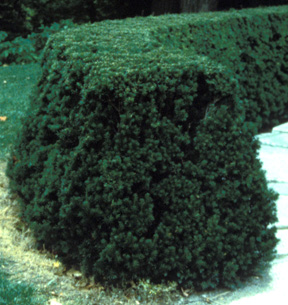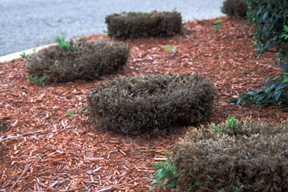Pruning evergreen shrubs
Tips, techniques and tools to consider when pruning your evergreen shrubs this spring.
This is Part 2 in a series on pruning ornamental plants.
With the onset of spring, gardeners gear up for their annual landscape “make over” by extracting dusty saws and hand pruners from the garage and investing in the season’s first sore muscles. Pruning can be one of the most perplexing rituals for the spring gardener because pruning requirements vary with each species.
I find it very entertaining to drive along and look around the neighborhood at over-enthusiastic pruning jobs. The green meatballs and tuna cans that people call shrubs outside their homes are pruning atrocities!
All plants have a “natural growth habit.” The best place to see the natural form of a foundation plant, such as yew or juniper, is an old cemetery. Given free reign, these plants we label as shrubs can be as tall as a house. You can see why it is difficult to prune them into various shapes.
Meatball and tuna can theory
There are few areas in one’s life where we have the ability to exercise supreme control without repercussion or police involvement except in our home landscape. Armed with a dull pair of shears or a power hedge trimmer, we can totally dominate our plants! The act of trimming may keep your shrubs from growing too large or too wide, but one should always question, “Was the shrub planted in the right location to begin with?”
Gardeners who attempt to exert “uniform conformity” over a shrub like a juniper may even be rewarded by deformity and even death if you’re not careful. I like to keep the chain saw (for removal) in the running as an option.
Sharpen your skills and your tools!
Where to start? If there’s one mistake I see home gardeners repeat often, it’s making poor cuts because of cheap tools. The adage “you get what you pay for” is definitely true here. If you invest in a quality pair of hand pruners and a good saw, I daresay you will never need to replace them. Sharpening or replacing the blade is imperative as well. Don’t go out there with rusty, dull tools and expect to do your shrubs any favors!
Plant response
The next thing you should understand is how the shrub will react to your pruning cuts. Pruning in general stimulates a growth response. Some methods of pruning generate more re-growth than others. To keep it simple, I will refer to “heading” and “thinning” cuts.
Cutting off the tip, or growing point, of a plant is called heading or heading back. By removing the point containing the terminal bud on a twig, other buds below that tip are stimulated to grow. This is a common practice used to “thicken” plants such as in a hedge or with herbaceous plants (pinching) such as Chrysanthemum.
A thinning cut is made by removing a branch at its point of origin along the stem or trunk. Ultimately, what you have done is redirect the way a plant is going to grow. Thinning stimulates very little in the way of re-growth and in many cases is the desired method of pruning for both size reduction and enhancing the shrub’s natural appearance.
Pruning yews
In many cases, we have planted or inherited foundation plants around our homes. When a plant is small, it is easy to underestimate the ultimate size of a shrub and most often, size control is the primary reason for pruning foundation plants. A common evergreen known as the yew easily adapts to being planted too close. Although they tend to grow a fair amount each season, when pruned properly, they can be dense and attractive for many years. Yews respond well to the heading cut I mentioned earlier. By hand trimming back the leggy shoots that appear each June, the plant can have a natural appearance and still stay in bounds. When the plant has gotten out of control, however, more drastic cuts deep into the “shoulders” of the plant are also acceptable and may ultimately result in the size reduction you are seeking. Don’t worry about cutting into the lower woody tissue on a yew because lower buds will respond and grow when exposed to sunlight. Temper your pruning into the lower woody tissue on a yew because lower buds are slow to respond in most cases.
No matter how much you prune back your shrubs, remember to keep the top of the plant more narrow than the bottom. This will encourage thickness at the base by allowing sunlight to stimulate growth all the way to the bottom.

When pruning a hedge, as in this yew, be sure to allow the bottom to be wider than the top. Photo credit: Rebecca Finneran, MSUE.
Pruning junipers
Junipers have a very different growth habit compared to the yew. Since they do not sprout from the interior branches when cut hard, gardeners need to be aware of the growing tips for best success. In this case, your best pruning success will be with the thinning method and avoid hedging shears all together. Junipers can easily outgrow their site unless thoughtful, size-reduction techniques are used. When a juniper has been cut repeatedly with hedge shears, it is likely to become deformed and die back beyond recognition.

Because junipers need their new shoots for continued growth, hedging these shrubs will end in failure. Photo credit: Rebecca Finneran, MSUE.
Select the branch that you want to remove and follow it all the way back into the center of the plant then cut. Since junipers tend to be “layered,” the feathery foliage on top of your cut will cover up the wound and keep the integrity of the plant. I see many junipers that have been planted in the wrong place. This is where you will need to evaluate whether or not to use the chain saw!
Find out about other educational resources and classes at www.migarden.msu.edu and at Finneran’s blog. Also see Part 1: Spring shape up: Tidying up your plants.
Related Source:



 Print
Print Email
Email




